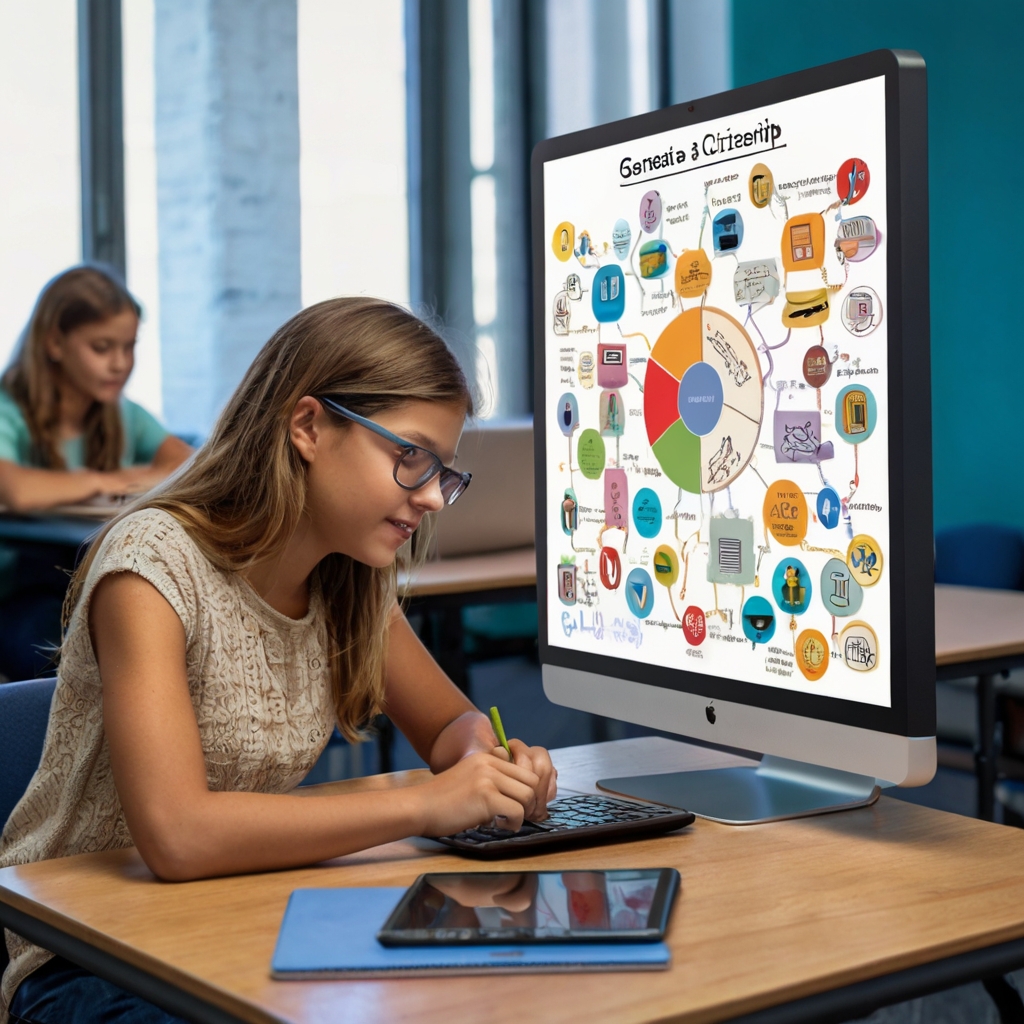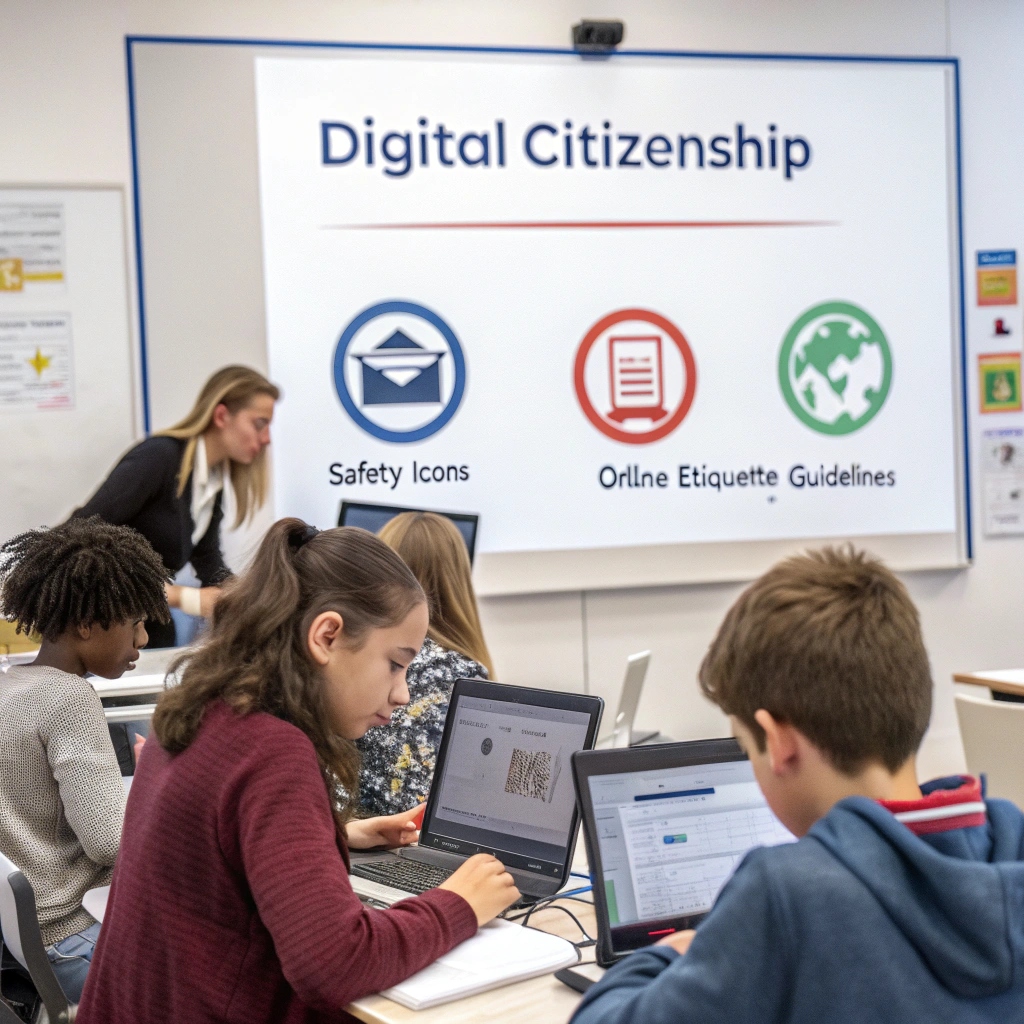The future of education is here, and it’s not what your parents expected.
As a society, we’re witnessing the emergence of digital citizenship as an essential tool for students to develop valuable life skills. From cybersecurity basics to social media responsibility, these frameworks will be pivotal in shaping young minds.
But how can educators effectively integrate this into their curriculum?
By doing so, they’ll equip students with the tools needed to thrive in a world where technology is constantly evolving.
In 2025, we’ll explore the key strategies and practical examples for teaching digital citizenship that will give your students a head start on an ever-changing landscape.
Recognizing Emotional Intelligence as an Essential Tool
Building a strong character is built by being aware of and managing emotions in school. This can be done through digital citizenship frameworks that promote emotional intelligence, social skills and communication.
Incorporating emotional awareness into education helps you recognize the impact your words have on others. By teaching students to reflect on their feelings, you help them develop empathy for peers who may not always understand how their actions are affecting those around them. This teaches them to consider perspectives from all viewpoints.
By being able to express emotions in a healthy way, people learn healthier relationships and improve communication skills which helps build resilience against negative situations that can lead to emotional distress. By doing so they develop more positive habits like self-awareness, empathy and effective problem-solving strategies for coping with life’s challenges.
When these values are instilled from an early age through education students will be able to navigate complex social situations better. This is especially true as technology advances and people interact digitally in their daily lives.
Developing Empathy through Virtual Reality Experiences

Empathy is a crucial component of integrating digital citizenship frameworks into student education, and one powerful tool for achieving it is Developing Empathy through Virtual Reality Experiences.
By immersing students in virtual reality experiences that simulate real-world scenarios, teachers can help them develop the skills necessary to navigate complex social situations. For instance, they might be tasked with caring for a virtual pet that requires attention from various members of society, including friends, family, or strangers. As they care for this digital companion, they’ll gain an understanding of how different individuals contribute to our communities.
Imagine walking into a classroom where students are fully immersed in virtual reality scenarios designed specifically to foster empathy. They might resolve conflicts with classmates through role-playing exercises that put them in each other’s shoes, or make informed decisions about environmental impact by exploring the effects of climate change on ecosystems.
Some popular virtual reality platforms for teaching empathy include Unity and Unreal Engine, which offer pre-made scenarios and activities tailored to emotional intelligence and social responsibility. These tools allow educators to create customized learning experiences that promote student engagement while developing essential life skills like active listening, open-mindedness, and conflict resolution.
For instance, a teacher can use VR to transport students into the lives of people from different cultures, providing them with opportunities for empathy-building through immersion in historical events or real-world scenarios. By experiencing these situations firsthand, educators can help their students become more effective communicators and collaborative problem-solvers.
Educators who implement VR experiences effectively will be able to enhance student outcomes by increasing prosocial behavior and reducing bullying incidents. For instance, a study on the impact of virtual reality-based empathy training found that participants exhibited significant reductions in aggressive thoughts and behaviors compared to those without such intervention.
When incorporating VR into your teaching practice, keep these tips in mind:
- Identify scenarios where empathy is critical for student success.
- Develop engaging activities that encourage students to think critically about complex social situations.
- Utilize virtual field trips to explore historical events or real-world environments.
By embracing this technology and its potential, educators can help their students develop the essential life skills of empathy and become more compassionate individuals who care deeply about others.
Fostering Inclusive Communities Online and Offline
Language is crucial for creating or perpetuating exclusionary environments, but it’s also a powerful tool for building inclusive ones. In this article, we’ll explore strategies to harness language and create welcoming spaces online and offline.
In schools, libraries, and community centers, consider hosting intercultural clubs or language exchange programs that encourage students from diverse backgrounds to interact with one another. These initiatives can help break down barriers between people from different cultural contexts by fostering shared experiences like book exchanges or volunteer projects. For instance, a school in the United States might establish a buddy system where English-language learners are paired with native speakers for conversation practice.
In contrast, social media platforms have a significant impact on digital citizenship. They require clear community guidelines that promote respect and empathy among users, as well as features like hate speech detection algorithms to prevent discriminatory content from spreading. For example, the platform Yikis has developed an AI-powered chatbot to report suspicious activity and provide guidance for users.
By fostering inclusive environments, we need to shift our mindset from seeing diversity as a challenge rather than an opportunity. This is demonstrated by organizations like Procter & Gamble, which uses inclusive design principles in their digital platform to ensure diverse perspectives are represented and valued.
In addition, online forums can become more welcoming with simple language tweaks. For instance, moderators might use phrases like “We welcome all views” or “We encourage respectful dialogue.” This subtle shift can create a culture of empathy and understanding among community members. Furthermore, incorporating emojis into digital communication can also help convey that the platform values diversity and inclusivity.
Intercultural clubs in schools are another effective way to promote social cohesion among students with different backgrounds.
Language plays a significant role in shaping interactions with others.
Creating inclusive environments requires a mindset shift from seeing diversity as an asset rather than a challenge. This is demonstrated by organizations like Procter & Gamble, which uses inclusive design principles in their digital platform to ensure diverse perspectives are represented and valued.
Balancing Personal Data with Cybersecurity Measures
Balancing personal data with cybersecurity measures becomes a crucial aspect of student education in today’s interconnected world. Students are exposed to various forms of technology that require them to handle sensitive information and navigate the online landscape, leaving them vulnerable to identity theft and other cyber threats.
Consider how a careless social media posting could compromise a student’s identity or lead to their personal data being stolen by scammers. For instance, sharing one’s email address or social security number on public platforms can make it easier for attackers to target them.
To prevent these risks, teaching students the importance of creating strong passwords is essential. This includes using words or characters that are not easily guessed and avoiding common password patterns like birthdays, anniversaries, or locations. Here’s a 5-step guide to create a secure password:
1. Use words or characters that are not easily guessed.
2. Avoid using similar phrases or patterns in multiple passwords.
3. Include a mix of uppercase and lowercase letters, numbers, and special characters.
4. Change your passwords regularly to stay up-to-date with the latest security measures.
5. Write down your password and store it securely.
In addition to strong passwords, safe online search practices are crucial for protecting personal data. This includes being cautious when clicking on links or downloading attachments from unknown sources, as these can contain malware that compromises user safety.
Another critical aspect of cybersecurity is maintaining digital citizenship through responsible social media use. This means setting boundaries and guidelines for what information should be shared publicly and how it’s presented to maintain a good reputation online. Students must also consider the impact of their behavior on others, such as cyberbullying or spreading misinformation.
To foster this awareness, teachers can create scenarios that illustrate these consequences in real-life situations. For example, students could role-play different social media scenarios and discuss how certain actions might affect them or their peers. By doing so, they’ll develop essential skills for navigating the digital world responsibly and protecting their personal data from potential threats.
By teaching these critical cybersecurity measures to students, educators can empower them with the knowledge needed to navigate today’s interconnected world safely.
Ethics in Artificial Intelligence Programming for Students

As technology becomes increasingly integrated into daily life, students must learn to navigate complex ethical issues in programming and artificial intelligence development. By studying digital citizenship frameworks, they can develop character that will benefit them throughout their lives.
Questionable data sources often involve collecting user information without consent, perpetuating biases in AI systems. For instance, facial recognition technology can be used to track individuals’ activities online or offline, raising concerns about surveillance and privacy. This raises fundamental questions about who has control over this information and how it is being used.
By learning how to program with ethical considerations in mind, students will not only develop a deeper understanding of AI but also help design more equitable and just technological solutions. For example, they can explore the impact of data collection on individual users, such as how it affects identity recognition and personalization. This includes discussing how to recognize and mitigate biases in machine learning algorithms.
Teachers can integrate these principles by discussing how digital citizenship frameworks address issues like surveillance capitalism. By incorporating these ideas into their curriculum, educators can help students develop a deeper appreciation for the complexities surrounding AI development.
By engaging with real-world examples and case studies, student learnings will better understand potential consequences of biased algorithms that may lead to further exploration in this topic
Building Trust and Transparency on Social Media Platforms
Creating a positive online environment requires more than just open communication channels; it necessitates building trust and transparency through digital citizenship frameworks in student education. As we navigate the complexities of social media, fostering an atmosphere where individuals feel comfortable sharing their true selves is crucial for promoting engagement and reducing cyberbullying.
To facilitate this process, schools can establish clear guidelines that outline acceptable user behavior on social media platforms. These policies should be concise yet comprehensive, detailing consequences for rule breaches while providing regular updates on data handling and protection practices. For instance, a school might specify rules regarding sharing personal information online or the use of profanity in digital communications.
Moreover, implementing mechanisms to report concerns or suspicious activity anonymously can help identify potential issues before they escalate into severe problems. This can be achieved through integrating chatbots or anonymous feedback systems on social media platforms.
In elementary schools, promoting authenticity through transparent language and user-friendly interfaces is essential for fostering trust among students. For instance, peer review policies that encourage open discussion and constructive criticism have been shown to increase student engagement in online forums (Kerr & Maloney, 2008). In the digital age of cyberbullying and data breaches, such initiatives are crucial.
To effectively promote authenticity through clear policies:
Incorporate Mechanisms for Anonymity: Many schools use anonymous feedback systems to ensure that students feel comfortable reporting concerns or issues without fear of judgment. This not only fostates an open environment where individuals can speak their minds but also helps in addressing potential problems before they escalate.
Example: To promote authenticity, consider incorporating mechanisms like this one into your school’s social media policies. For instance, you might provide a dedicated channel for anonymous feedback or concerns, ensuring that students feel comfortable sharing their thoughts without fear of judgment.
Design Clear Guidelines: Developing clear guidelines can help foster trust and transparency in online communities. These guidelines should outline acceptable user behavior on social media platforms while providing regular updates on data handling and protection practices.
Example: When crafting your school’s social media policies, make sure to include clear expectations for student behavior, consequences for rule breaches, and information about how you handle sensitive topics like cyberbullying or data breaches.
Encourage Constructive Feedback: Foster a culture that encourages constructive feedback. This can be achieved through peer review systems where students engage in open discussions on their work.
Example: By implementing mechanisms to foster this kind of dialogue, you encourage collaboration and shared learning, ultimately leading to improved outcomes for your students.
Incorporating these measures into student education will not only build trust but also promote a positive online environment. By doing so, schools can create spaces where students feel comfortable sharing their thoughts without fear of judgment or repercussions. This allows for more constructive dialogue and open discussion among users.
The Role of Digital Literacy in Financial Education
Incorporating digital citizenship frameworks into student learning is crucial in today’s digitally-driven world. The average American spends over 6 hours daily on social media, making it a pressing concern for educators to equip students with essential skills to navigate an increasingly complex online landscape. Digital literacy encompasses more than just technical proficiency – it involves understanding how to critically evaluate information, protect personal data, and make informed decisions in the digital realm.
Digital tools like budgeting apps and online banking platforms provide hands-on experience in managing finances efficiently. By leveraging these resources, students can develop skills such as critical thinking, media literacy, and time management. For instance, popular budgeting apps like Mint or You Need a Budget (YNAB) teach users to categorize expenses, track income, and set financial goals – essential habits for responsible spending.
To create smart financial decisions on social media requires more than just basic math skills; it demands an understanding of algorithms that manipulate users into making impulsive purchases or poor investment choices. For example, did you know that Facebook’s News Feed algorithm uses complex factors such as user behavior and demographics to curate content? Recognizing these tactics helps students avoid falling prey to targeted advertisements, which often prioritize short-term gains over long-term financial stability.
To teach digital citizenship frameworks effectively in the classroom, educators can use real-world examples from everyday life. For instance, comparing a budgeting app’s features to a personal finance advisor would help students grasp how tools like Mint or YNAB work. To foster critical thinking skills, instructors can assign tasks that require analyzing online advertisements or evaluating the credibility of sources on social media.
Incorporating digital citizenship frameworks into student learning is not just about teaching kids how to handle their finances in a digital world; it’s also about recognizing and resisting manipulations by companies like Facebook or Google. For example, students should learn to identify biases in data-driven advertising campaigns that prioritize profit over financial stability. By doing so, they’ll be better equipped to make informed decisions online.
Let me know if you’d like any changes!
Using Virtual Environments to Practice Collaboration Skills
Integrating virtual environments into student education can have a significant impact on developing teamwork skills. Virtual collaboration tools like Discord and Slack provide dedicated spaces to facilitate seamless communication among team members, reducing noise and increasing productivity.
For example, Discord’s channels allow for organized conversation and file sharing, while its direct messaging capabilities help reduce irrelevant chatter. This enables students to focus on their tasks without distractions, promoting a more efficient workflow. Similarly, Slack’s customizable notification settings ensure that team members receive the information they need at critical moments.
Companies like Google and Microsoft use virtual collaboration tools extensively in real-world scenarios. For instance, Google uses Slack for its teams, demonstrating its ability to facilitate communication across geographical boundaries. In contrast to traditional office settings where meetings can be time-consuming, these platforms enable quick responses and immediate feedback, saving valuable hours of a team’s day.
To create an effective learning environment with virtual collaboration tools, educators must establish clear expectations from the outset. This includes defining roles and responsibilities for each student as well as outlining specific participation guidelines to avoid conflicts or confusion during group projects.
For instance:
- Create a shared document outlining project objectives, deadlines, and milestones
- Hold regular video conference meetings to ensure all team members are on the same page
By doing so, educators can harness the potential of virtual collaboration tools while minimizing their drawbacks.
Addressing Online Harassment with AI-Powered Reporting Tools

Online harassment in schools and universities is a growing concern that requires immediate attention from educators, policymakers, and technology providers. In today’s digital landscape, students are facing an increasing risk of online harassment that can take a toll on their academic performance and overall well-being.
For instance, studies have shown that exposure to cyberbullying can lead to increased rates of depression, anxiety, and PTSD in young people. This is because online harassment can be especially damaging when it involves repeated interactions or persistent messaging. AI-powered reporting tools designed specifically for student safety are a crucial step towards creating safer learning environments.
These tools use machine learning algorithms to analyze patterns of online behavior and identify potential threats. For example, chatbots that can quickly scan messages or posts for suspicious content have been shown to be effective in flagging potentially harassing language or tone. By integrating these tools into education systems, educators can better support students who experience online harassment.
AI-powered reporting tools also provide immediate responses to victims of online harassment by alerting them to the situation and offering helpful resources. This not only alleviates feelings of anxiety but empowers students to speak out against bullying in real-time. Furthermore, research suggests that using technology-enabled solutions is associated with reduced rates of cyberbullying.
When implementing AI-powered reporting tools, it’s essential to consider a few key factors: ease of report submission and support systems for educators and counselors. A dedicated platform or app should be easily accessible and allow students to report incidents quickly. This enables swift action from school administrators, who can then provide targeted support.
Some notable examples of AI-powered reporting tools include those that use natural language processing (NLP) to analyze messages for sentiment analysis, detect emotional distress in online interactions, or identify patterns indicating potential harassment (4).
To further address this issue, consider incorporating educational strategies into your digital citizenship curriculum. A suggested approach is creating a resource database with examples of acceptable and unacceptable communication forms. This could include scenarios that illustrate how these differences can impact relationships and well-being.
By implementing AI-powered reporting tools in education systems, educators can create safer learning environments where students feel empowered to speak out against online harassment.
Building Blocks of Character: Integrating Digital Citizenship Frameworks into Student Education in 2025
Understanding the Impact of Social Media on Mental Health
Great students won’t be left behind. The pressure to perform and constantly connected digital devices have created a perfect storm that can negatively impact young minds. If schools fail to address social media’s influence, students may struggle with anxiety, depression, and other mental health issues.
And The sooner schools integrate these frameworks into their curriculum, the more likely they are to create a generation of digitally literate individuals equipped to navigate the complexities of online interaction.
By incorporating digital citizenship education early on in school curricula it can help reduce bullying by teaching kids how to act responsibly towards others.
So, trust your instincts and prioritize student well-being today. Be bold, engage schools in this conversation about mental health.
Take decisive action today to build a better future for young minds that are equipped with the skills they need to thrive in an increasingly complex digital world.
